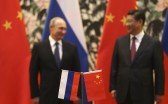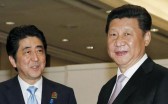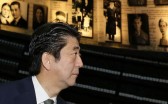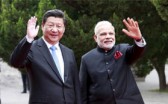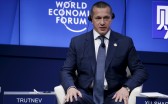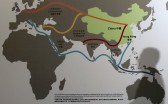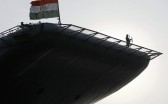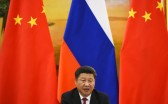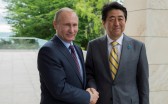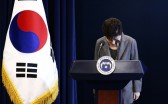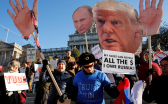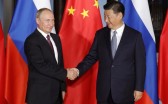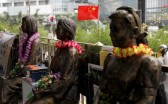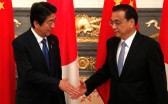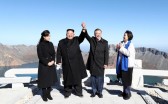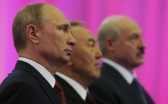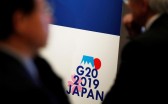“History Bows to Strategy”
In East Asia, disputes over history seem to be either roiling the region’s international relations—or lurking just beneath the surface. China emphasizes Japan’s atrocities in the Sino-Japanese war, notably the Nanjing Massacre, in its history education, commemoration, and state-controlled media. History issues also rankle Seoul and Tokyo. During the Park Geun-hye era, toxic relations over history issues yielded, surprisingly, to the 2015 agreement on the “comfort women.” But criticized intensely by both sides, its longevity is uncertain. To what extent will disputes over history consume the region’s energies in the future?
Historical reconciliation—or the lack of it—is powerfully affected by the strategic environment. Countries pushed together by common strategic interest tend to minimize history disputes. By contrast, countries engaged in strategic competition will emphasize narrative difference and distance.1 According to this logic, in the future, Japan will continue to enjoy good relations with its maritime neighbors (with which it is increasingly seeking to cooperate). By contrast, history will continue to haunt Sino-Japanese relations. As for the history problem between Japan and the Republic of Korea (ROK), its future will depend on which direction Seoul tilts in East Asia’s emerging great-power competition.
Shared Strategic Goals and Historical Reconciliation
What determines on what fronts the history wars rage on—versus when the guns go silent? Strategic factors are a major issue. When a country sees another country as a security threat, its government will mobilize its society against that threat. In addition to building up military power, it creates a narrative that emphasizes the enemy’s hostile nature. Thus, as John Dower has chronicled, the United States and Japan created racist propaganda to mobilize their societies and soldiers in World War II.2 Today, North Korean propaganda depicts Americans as vicious “Yankee wolves.”3 Hostile narratives whitewash one’s own past violence and ignore any suffering the enemy endured.
Alternatively, strategic conditions might push countries together. A country might see a former adversary as a potentially vital economic partner, or as a valuable ally against a shared security threat. Because leaders have to show their people that the other country is a responsible and trustworthy partner, cooperation requires a basic level of acceptance and respect. This demands on both sides a movement away from a hostile narrative, toward one that requires acknowledgment of past violence and empathy on both sides.4
For example, in post-World War II Europe, shared fears of the Soviet Union encouraged France and West Germany to reconcile. The West Germans accepted responsibility for the war and later—through formal apologies, history education, and memorialization—famously acknowledged and atoned for their wartime aggression and atrocities.5 Starting in the late 1950s, French leaders softened what had been a deeply hostile national narrative toward the Germans. In a visit to West Germany in 1962, Charles de Gaulle praised an audience of young West Germans as the “children of a grand people,” who “enriched the world, who bequeathed it a rich spiritual, scientific, and philosophical heritage.” Later, François Mitterrand would mourn the “four million fine, brave Germans” who died in the war. French and West German leaders partnered in crafting several important events: de Gaulle and Konrad Adenauer attending mass at Rheims Cathedral in 1962; Mitterrand and Helmut Kohl holding hands at Douaumont cemetery in 1984; and numerous French and German leaders embracing and laying wreaths together at commemorations of Normandy or Armistice Day. This amicable narrative supported French policies of cooperation within the European Community and within NATO.
In East Asia, strategic conditions similarly encouraged reconciliation, and the crafting of a friendly narrative, between Japan and the United States. After World War II, each country had ample material for a ferocious history problem—had it served their purposes to create one. Instead, pushed together by the Cold War, they chose to cooperate, putting the animosity of the wartime era behind them. Recently, their friendly remembrance of the war was evident at Hiroshima, where in 2016 Barack Obama and Abe Shinzo staged a poignant ceremony. Obama did not apologize for the bombings but acknowledged the suffering of the victims. Although their national narratives about the bombings and the broader war certainly diverge, the two leaders emphasized themes that they both could support: the goal of nuclear abolition, the tragedy of war, and the success of bilateral reconciliation.6
To be sure, other factors, notably domestic politics, will influence East Asia’s history problems. Authoritarian leaders lacking electoral legitimacy often scapegoat their former adversaries; in democracies, liberal and conservative leaders have very different philosophies about the proper way to remember the past. But regardless of leaders’ political orientation or regime type, countries that join together to contain a joint security threat harmonize their national narratives and minimize history disputes. Strategic competitors face no such incentive, and indeed have incentives to stoke animosity about the past.
The Future of Asia’s History Problems
What does this argument predict for the future of East Asia’s “history problems”? First, history disputes will be unlikely in Japan’s relations with the United States and other maritime powers. Indeed, Japan’s relations with Australia, India, the Philippines, and Singapore are not troubled by history disputes. These countries built friendly and productive relations with Japan after World War II, and—as China continues to grow and exhibit greater aggressiveness—are deepening their cooperation with Tokyo: creating a narrative emphasizing (in contrast to China) liberal democracy and the defense of a “rules-based order.”7 In their friendly narrative, Japan and India both remember and honor Radhabinod Pal, an Indian judge in the Tokyo Trials who dissented from the verdicts.8 When Abe visited Yasukuni Shrine in 2013—prompting outcry from China in particular—New Delhi made no objection. As for the Philippines, Manila and Tokyo have been unencumbered by history problems; after Abe’s Yasukuni visit, one Filipino commentator noted, “not a word or even a whimper of protest was heard from Manila.”9 In 2016, Japan’s Emperor and Empress attended a ceremony in the Philippines to honor the war dead.10
By contrast, history problems between China and Japan will likely grow worse as the two countries increasingly view each other as a competitor. China has overtaken Japan economically, and has steadily modernized its military. As Chinese power has grown, Beijing has adopted a more aggressive posture in its regional territorial disputes, including over the islands known as Senkaku by Japan, and Diaoyu by China.11 The Chinese narrative has also become increasingly hostile to Japan. “The People’s Republic of Amnesia,” as journalist Louisa Lim calls it, presents a highly scripted version of history to the Chinese people, controls access to information, and conceals Chinese Communist Party (CCP) atrocities.12 China’s historical narrative—seen through television, film, commemoration, museums, and textbooks—emphasizes Japanese wartime atrocities. With relations between Japan and China moving in a more competitive direction, the history problem between the two countries should worsen.
Will History Continue to Haunt Seoul and Tokyo?
The future of the history problem between Japan and the ROK is less clear—in large part because of uncertainty in the two countries’ strategic relationship. Many observers (particularly Americans) argue that because Tokyo and Seoul share many strategic interests, they should engage in more security cooperation. Indeed, in some ways, the countries do share a great deal; both are threatened by North Korea and allied with the United States. They are liberal democracies and have thriving economic relations.
Thus, some observers, such as Japanese specialist Michishita Narushige, expect security forces to ultimately push the two countries together, in spite of the “nationalistic rhetoric that the countries’ leaders sometimes adopt with their respective domestic constituencies.” Michishita argues, “ties between Japan and South Korea are fundamentally driven by pragmatic and hard-nosed considerations, especially about security. Too often this simple fact goes unacknowledged, even though it should be a source of some reassurance, especially at a time when North Korea seems increasingly belligerent and China more and more assertive.”13
While the two countries do have many commonalities, their interests also diverge. Facing a North Korean ground threat, South Korea fields a far more powerful military, and relies on the United States; the additional contributions of alliance with Japan (a maritime power) would be marginal. Japan, for its part, has long been horrified at the prospect of being drawn into a conflict on the Korean Peninsula.
The two countries’ views of China also differ. Whereas Japan sees China as a serious security threat, South Korea has, only recently, enjoyed “honeymoon” relations with China, and has no territorial disputes with it currently deemed significant. Seoul is attempting to maintain its security alliance with the United States while also maintaining good relations with China: its most important trading partner, and the only country with the ability to exert influence over North Korea. To reassure China that it is not balancing against it, Seoul has distanced itself from Tokyo through a narrative that emphasizes Japan’s wartime violence and China-ROK amity. In this narrative, statues and museums lionize Ahn Jung-geun (a Korean who in 1909 assassinated the Japanese governor-general of Japanese-occupied Korea).14
In recent years, however, relations between Beijing and Seoul have cooled. China, furious at South Korea for cooperating with the United States in the THAAD missile defense system, punished South Korea (and the firm Lotte) with economic coercion.15 If this proves a temporary setback, and relations between the two countries settle back into their earlier warmth, expect history problems with Japan to worsen: Seoul would emphasize the Dokdo/Takeshima dispute with Japan, stage more celebrations of Ahn Jung-geun, and demand more Japanese apologies and other gestures.16
If, however, recent developments suggest that Seoul is increasingly alarmed at the prospect of living in a region dominated by a powerful China, South Korea may well move closer to Washington and Tokyo.17 As it does, South Korean leaders (as they have in previous eras of cooperation) would move history problems from the front to the back burner.18 The two countries could encourage a more harmonized narrative by hosting shared sporting events (such as the 2002 co-hosting of the World Cup), and by signing agreements that express a commitment to moving forward.
A surprising recent sign of this was the 2015 agreement on the “comfort women”: an issue that has emerged at the forefront of the history problems between Japan and South Korea. In this deal, which included a Japanese apology and $8.3 million in official reparations to the survivors, the two countries pledged to move past the issue.19 If the deal survives and the two countries continue to move closer together, perhaps they will harmonize their narratives on this issue as well, leading someday to a Japanese leader joining a South Korean one to drape a scarf around the neck of a “comfort woman” statue in Seoul—rather than demand it be torn down.
Finally, depending on the future of relations between South Korea and the United States, East Asia may confront a whole new set of history problems. US-ROK relations have grown strained given American concerns about North Korea’s emerging intercontinental nuclear capability. If these events promote a “decoupling” of the US-ROK alliance,20 history issues between the two countries, long suppressed in support of a strong alliance, may emerge. South Koreans have long memories about events such as a US massacre during the Korean war at No Gun Ri; the Carter administration’s support for Chun Doo-hwan in violently suppressing the Gwangju uprising; and the exploitation of South Korean women that has accompanied the US military presence on the peninsula.21 In relations between the ROK and the United States, as in these other relationships, history will smolder, or ignite, depending on strategic need.
1. This essay draws on Jennifer Lind, “Making Up Isn’t Hard to Do,” Foreign Affairs, March 5, 2015.
2. John W. Dower, War Without Mercy: Race & Power in the Pacific War (New York: Pantheon, 1993).
3. B. R. Myers, The Cleanest Race: How North Koreans See Themselves and Why It Matters (New York: Melville House, 2011).
4. Charles Kupchan, How Enemies Become Friends: the Sources of Stable Peace (Princeton: Princeton University Press, 2010); Yinan He, The Search for Reconciliation: Sino-Japanese and German-Polish Relations since World War II (Cambridge: Cambridge University Press, 2009).
5. Thomas U. Berger, War Guilt and World Politics After World War II (Cambridge: Cambridge University Press, 2012); Jennifer Lind, Sorry States: Apologies in International Politics (Ithaca, NY: Cornell University Press, 2008).
6. Jennifer Lind, “As Obama Goes to Hiroshima, Here Are 3 Principles for a Successful Visit (with No Apologies),” The Washington Post, May 26, 2016.
7. Natalie Obiko Pearson, “Abe-Modi deals shows Asia’s top powers moving to keep rising China in check,” The Japan Times, December 14, 2015.
8. Jonathan Soble and Victor Mallet, “India’s Narendra Modi Chides China as He Embraces Japan,” The Financial Times, September 2, 2014; Ministry of External Affairs, India, “Prime Minister Shinzo Abe’s Visit: Pinnacle of India-Japan Relations,” accessed February 12, 2018, http://mea.gov.in/in-focus-article.htm?22762/Prime+Minister+Shinzo+Abes+visit+pinnacle+of+IndiaJapan+relations.
9. Mong Palatino, “Has Manila Forgotten Japan’s War Atrocities?” The Diplomat, January 29, 2014, at https://thediplomat.com/2014/01/has-manila-forgotten-japans-war-atrocities/.
10. Yuki Tatsumi, “Japan’s Emperor Visits Philippines: Major Takeaways,” The Diplomat, February 6, 2016.
11. Robin Harding and Charles Clover, “China Steps up Incursions around Disputed Senkaku Islands,” The Financial Times, January 21, 2016.
12. Louisa Lim, The People’s Republic of Amnesia: Tiananmen Revisited (Oxford, New York: Oxford University Press,
13. Narushige Michishita, “Japan and South Korea, the Friendly Foes of East Asia,” The New York Times, February 9, 2018.
14. “The Politics of Statues,” The Economist, November 23, 2013; In-Soo Nam, “Remembering Ahn’s Assassination – In Model Form,” The Wall Street Journal, March 5, 2014.
15. Evan A. Feigenbaum, “Is Coercion the New Normal in China’s Economic Statecraft?” Carnegie Endowment for International Peace, July 25, 2017, http://carnegieendowment.org/2017/07/25/is-coercion-new-normal-in-china-s-economic-statecraft-pub-72632.
16. Motoko Rich, “Japan Balks at Calls for New Apology to South Korea Over ‘Comfort Women,’” The New York Times, January 12, 2018
17. Jennifer Lind, “Life in China’s Asia,” Foreign Affairs (March/April 2018).
18. Victor D. Cha, Alignment Despite Antagonism: The United States-Korea-Japan Security Triangle (Stanford, CA: Stanford University Press, 1999).
19. Choe Sang-Hun, “Japan and South Korea Settle Dispute Over Wartime ‘Comfort Women,’” The New York Times, December 28, 2015.
20. Ankit Panda, “Under Trump, A Looming North Korean ICBM Threat Brings Alliance ‘Decoupling’ Fears Back to East Asia,” The Diplomat, May 2, 2017, https://thediplomat.com/2017/05/under-trump-a-looming-north-korean-icbm-threat-brings-alliance-decoupling-fears-back-to-east-asia/.
21. Truth Among Allies,” Economist, February 17, 2000; Tim Sherrock, “The Gwangju Uprising and North Korea,” 38 North, October 3, 2017, https://www.38north.org/2017/10/tshorrock100317/; Katharine H. S. Moon, Sex Among Allies: Military Prostitution in U.S.-Korea Relations (New York: Columbia University Press, 1997).

